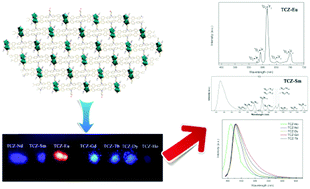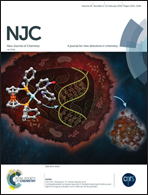Syntheses, structures, luminescence and magnetic properties of seven isomorphous metal–organic frameworks based on 2,7-bis(4-benzoic acid)-N-(4-benzoic acid)carbazole†
Abstract
We report herein seven novel lanthanide metal–organic frameworks (Ln-MOFs), [M(L27)(DMA)(H2O)·XH2O]n (TCZ-M), (M = Nd, Sm, Eu, Gd, Tb, Dy, Ho), (X = 2 or 3) (H3L27 = 2,7-bis(4-benzoic acid)-N-(4-benzoic acid)carbazole, DMA = N,N-dimethylacetamide, TCZ = “T”-shape carbazole-based MOFs, L27 = fully deprotonated H3L273− ligand). X-ray crystallography showed that all the TCZ-M (M = Nd, Sm, Eu, Gd, Tb, Dy, Ho) are isomorphous and possess a 3,6-connected three-dimensional (3D) framework with a point symbol of {4·62}2{42·610·83}. The photoluminescence measurement indicates that TCZ-Eu shows reddish-orange emission bands and TCZ-Sm shows both visible and near-infrared (NIR) emission bands. Magnetic susceptibility measurements show deviations from the Curie law mainly owing to the split of the ground term due to the ligand field and spin–orbit coupling in TCZ-Eu and TCZ-Sm. The magnetic properties of TCZ-M (M = Nd, Gd, Tb, Dy, Ho) are also investigated, and the results indicate a ferromagnetic interaction between the Tb3+ magnetic centers in TCZ-Tb and the antiferromagnetic interactions in TCZ-M (M = Nd, Gd, Dy, Ho).



 Please wait while we load your content...
Please wait while we load your content...